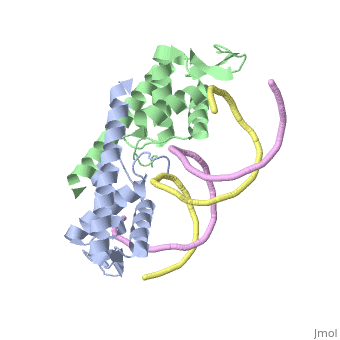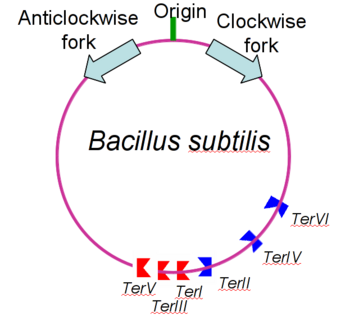Replication Termination Protein
From Proteopedia
FunctionThe replication termination protein or replication terminator protein (RTP) is one of only two well-defined proteins known to be involved in arresting DNA replication forks, the other being a protein known as Tus (termination utilisation substance or DNA replication terminus site-binding protein or ter-binding protein) from E. coli [1]. RTP was discovered in Bacillus subtilis and has been identified as a DNA binding protein of the winged helix family that forms a dimer of 29kDa. This dimeric form has been shown to have an exceptionally high affinity for its cognate binding sites( Kd ~10-11M-1)[2], otherwise known as Termination sites (Ter sites). These Ter sites are found in multiple locations in the B. subtilis genome [3]. For more details see:
Termination of ReplicationBacterial replication like that found in Bacillus subtilis consists of two replication forks that travel in opposite directions around the same circular strand of DNA. These replication forks begin at the origin of replication (OriC) and travel in clockwise and anticlockwise directions [4]. To prevent the strand from being over replicated each strand needs to be terminated roughly opposite the OriC and then joined to form the complete duplicated strand of DNA. As such the Ter/RTP complexes have found to be polar in their action; that is that different Ter sites are capable of only blacking DNA replication from one direction only. Since Ter sites are found facing both forks of replication, and the combination of both are capable of stopping both strands of replication, they are often termed as replication traps. The arresting of replication is achieved by the binding of two dimers to each Ter site, with the two RTP binding sites referred to as site A and site B. Site B shows a higher affinity for RTP and binds first, with site A then being filled with another RTP dimer cooperatively. This differential affinity for RTP is cited as a possible reason for the observed polarity of the termination [5]. RTP StructureRTP is a DNA binding protein from Bacillus Subtilis that uses a helix-loop-helix binding motif. In solution it shows a symmetric structure typical of the winged helix loop helix family, with an unstructured end, first alpha helix , unstructured loop that is equivalent to the first beta sheet , helix loop helix structure (-), 2 beta sheets with a connecting loop that makes up the 'wing' structure and an additional long alpha helix involved in dimerisation .[6] Binding of Rtp to the assymetric B portion of the Ter site changes its conformation into an assymetric 'wing-up wing-down' structure. The contacts upstream with rtp dimer bound to A-site while the : Contacts with phosphate backbone of downstream DNA
Residues that bind in both monomers: Red Residues that bind only in wing-up: Green Residues that bind only in wing-down: Blue
Replication MechanismDebate over the mechanism of Replication termination by RTP has led to a number of mechanisms being proposed. Original work on this question was hampered by an incorrect structure of RTP being released. This structure was produced in solution and was shown to be a symmetric dimer[8] Later crystallisation of the protein bound to DNA showed the RTP formed a asymmetric dimer when bound to cognate sequences [9] . One early study proposed that the asymmetric interaction between terminator protein and terminator DNA contributed to the observed polarity, with later studies showing that the RTP/Ter complex contained partially unwound DNA, suggesting a locked complex was responsible. More recent data has implicated that protein -protein interactions between RTP and the helicase is primarily responsible for termination and that this mechanism is modulated by the asymmetrical interactions described above [10]. 3D structures of replication termination proteinReplication termination protein 3D structures References
| ||||||||||||||||||||||||||||||||||||||||||||||||||||||||||||||||||
Proteopedia Page Contributors and Editors (what is this?)
Michal Harel, Alexander Berchansky, Craig Mooney, Joel L. Sussman



